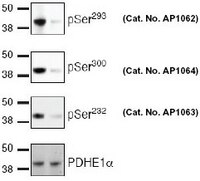AP1064 Sigma-AldrichPhosphoDetect™ Anti-PDH-E1α (pSer³⁰⁰) Rabbit pAb
This PhosphoDetect™ Anti-PDH-E1α (pSer³⁰⁰) Rabbit pAb is validated for use in Immunoblotting, Immunocytochemistry for the detection of PDH-E1α (pSer³⁰⁰).
More>> This PhosphoDetect™ Anti-PDH-E1α (pSer³⁰⁰) Rabbit pAb is validated for use in Immunoblotting, Immunocytochemistry for the detection of PDH-E1α (pSer³⁰⁰). Less<<Synonyme: Anti-Pyruvate Dehydogenase pSer³⁰⁰ Rabbit pAb
Empfohlene Produkte
Übersicht
| Replacement Information |
|---|
Key Spec Table
| Species Reactivity | Host | Antibody Type |
|---|---|---|
| H | Rb | Polyclonal Antibody |
Preis & Verfügbarkeit
| Bestellnummer | Verfügbarkeit | Verpackung | St./Pkg. | Preis | Menge | |
|---|---|---|---|---|---|---|
| AP1064-50UG |
|
Kst.-Ampulle | 50 μg |
|
— |
| Product Information | |
|---|---|
| Form | Liquid |
| Formulation | In 150 mM NaCl, 100 mM Tris-Glycine, pH 7.4. |
| Negative control | HEK293 cells treated with dichloroacetate |
| Positive control | HEK293 cells |
| Preservative | ≤0.1% sodium azide |
| Quality Level | MQ200 |
| Physicochemical Information |
|---|
| Dimensions |
|---|
| Materials Information |
|---|
| Toxicological Information |
|---|
| Safety Information according to GHS |
|---|
| Safety Information |
|---|
| Product Usage Statements |
|---|
| Packaging Information |
|---|
| Transport Information |
|---|
| Supplemental Information |
|---|
| Specifications |
|---|
| Global Trade Item Number | |
|---|---|
| Bestellnummer | GTIN |
| AP1064-50UG | 04055977227802 |
Documentation
PhosphoDetect™ Anti-PDH-E1α (pSer³⁰⁰) Rabbit pAb SDB
| Titel |
|---|
PhosphoDetect™ Anti-PDH-E1α (pSer³⁰⁰) Rabbit pAb Analysenzertifikate
| Titel | Chargennummer |
|---|---|
| AP1064 |
Literatur
| Übersicht |
|---|
| Rardin M.J., et. al. 2009. Anal. Biochem. 2, 157. Seifert, F., et al. 2007. Biochemistry 21, 6277. Lee, J., et al. 2007. Mol. Cell Prot. 4, 669. Patel, M.S. and Korotchkina, L.G. 2006 Biochem. Soc. Trans. 34, 217. Korotchkina, L.G., et al. 2001. J. Biol. Chem. 40, 37223. |









